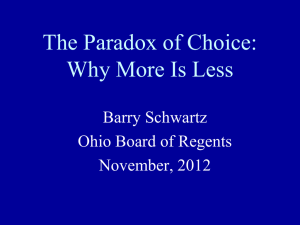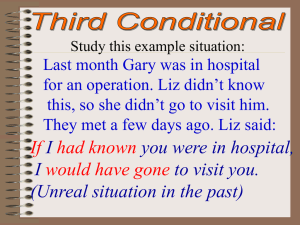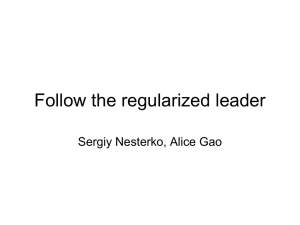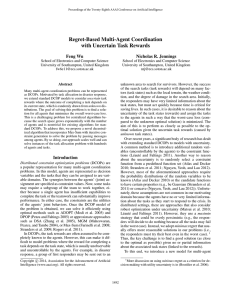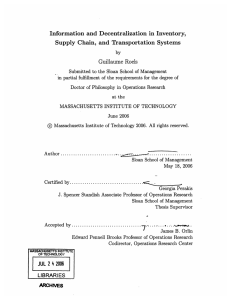Skaidrė 1
advertisement
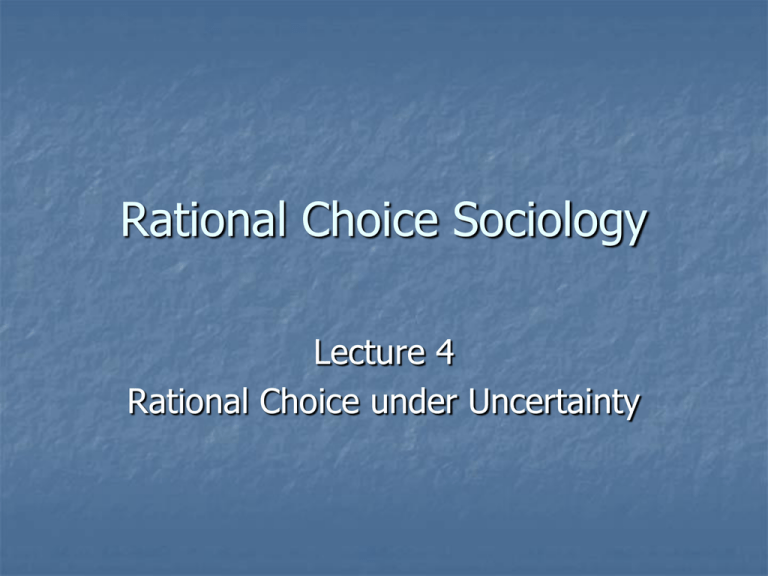
Rational Choice Sociology Lecture 4 Rational Choice under Uncertainty Is the Problem of Rational Choice under Uncertainty Important? An actor chooses under uncertainty if she is not able to ascribe probabilities to the possible outcomes of her alternative actions How often the situations of choice under uncertainty happen? According to proponents of the theory subjective expected utility (seu), almost never, because actors almost always have subjective probabilities (it is even difficult to find an undisputable example of such situation). There are no situations where special rules for choice under uncertainty could be applied. The Bayesian rule (maximization of seu) is universal According to proponents of objectivistic version, Bayesian rule is applicable only if the actor has statistical data about the relative frequencies. If her subjective probabilities are not grounded in such data, she chooses under uncertainty. Situations of the choice of uncertainty include those where probabilities of the unique or rare events are involved. For such situations, special rule of choice is needed. Unsufficient reason rule Under uncertainty, consider all outcomes as equally probable. Multiply u by equal p and choose the action with greatest expected utility index; Or: choose the action with prospect that has greatest average utility C1 C2 C3 C4 Action 1 12 0 9 2 EU1=5,75 Action 2 5 6 1 9 EU2=5,25 Maximin/Minimax rule (or: radical pessimism rule) Under uncertainty, choose the action with best worst outcome (or: choose the best among worst) Alternatively: maximize the greatest minimal payoff (maximin) or Minimize the greatest maximal loss (minimax) Maximin/Minimax rule: example 1 C1 C2 C3 C4 C5 Action1 12 0 X 3 2 6 Action2 8 2 1 X 3 4 Action3 12 22 33 4X! 6 Maximin/Minimax rule: example 2 C1 C2 C3 C4 C5 Action1 -5 -9 -6 -8 -10X Action2 -9X! -1 0 -7 -8 Action3 -5 -8 -9 -12X -1 Maximax rule (or: radical optimism rule) C1 C2 C3 C4 C5 Action1 22 -9 9 11 81 X ! Action2 3 -7 1 7X 4 Action3 1 4 5 -6 8X What if there are two prospects with equally good worst or best outcomes? Apply leximin and leximax rules: choose the action which has better second worst outcome (leximin) or better second best outcome C1 C2 C3 C4 C5 Action 1 8 9+ 3 0 XX -1 X Action 2 12 78+ 44 ++! -10 X 8 9 2 XX! 9 22+ -1 X 78+ 33 ++ -2 X 4 12 Best according leximax Action 3 Best according leximin Action 4 Criticism of maximin/minimax and maximax rules C1 C2 Action1 0 1 000 000 Action2 0,01 X 1 C1 C1 Action1 2 1 Action2 -1000 000 Or: to break the backbone 3X Minimax regret rule: choose the action that brings minimal maximal regret if choice will be unsuccesfull: table left: utility indexes; table right: regret indexes C1 C2 Action 1 0 100 Action 2X 1 1 C1 C2 Action 1 -1 X 0 Action 2 0 -99 Calculation of regret indexes (transformation of utility matrix into regret matrix) and choice according minimax regret rule NB: utility indexes should be interval scale Regret index Rij= uij-umaxj In each column, find the outcome with greatest utility index; subtract this index from the utility indexes of each outcome in the same column. Find in each prospect the greatest (worst) regret index (=maximal regret) Choose the action whose greatest regret index is least (=least maximal regret) Minimax regret rule: example C1 C2 C3 C4 A1 -2 5 -8 -7 A2 -5 90 11 A3 4 20 7 C1 C2 C3 C4 A1 -6 -85 X -19 -21 -12 A2 -9 0 0 -26X! 14 A3 0 -70 X -4 0 Optimism-pessimism rule There are more candidates to play the role “middle between pessimism and optimism” rules, but they are increasingly complex and have demanding conditions of application (utility indexes measured at interval level and sometimes some complementary data). E.g. The optimism/pessimism rule: Choose the action with the greatest sum of the utilities of best and worst oucome weighted by optimism and pessimism indexes Action Ai > Aj, if a × u max (Ai) + 1-a ×umin (Ai) > a × u max (Aj) + 1-a ×umin (Aj) Where a is optimism index, 1-a is pessimism index If a=0, then optimism-pessimism rule collapses into maximin/minimax rule; if 1-a=0, then optimism-pessimism rule collapses into maximax rule Optimism-pessimism rule (example) C1 C2 C3 C4 -2 5 -8 -7 Uop(A1)= 0,3×5 + 0,7×8=1,5+ (-5,6)= -4,1 A2 ! -5 90 11 -12 A3 20 7 14 Uop(A2)= 0,3×90 + 0,7×-12 =27+ (-8,4)= 18,6 Uop(A3)= 0,3×20 + 0,7×-4 =6+ (-2,8)= 3,2 A1 -4 Which rules people follow choosing under uncertainty? It is empirical question! Which rule is best? (normative question) Undecided: this is question, who is more rational, optimist or pessimist, or which mix of them is rational… Most decision analysts say we should accept a and 1-a as data, like we accept preferences
